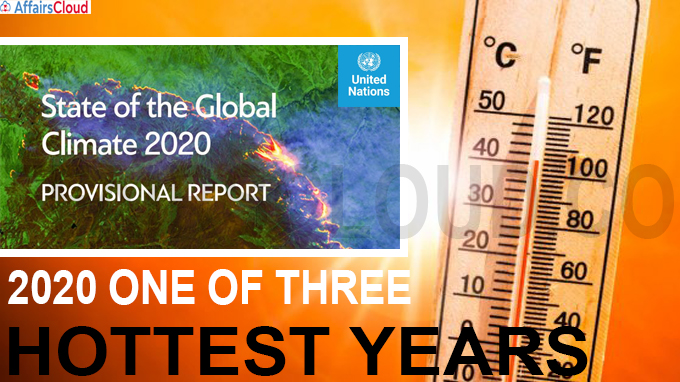 According to the “State of the Global Climate 2020” Interim report released by the United Nations World Meteorological Organization (UN-WMO) based on the temperature data from January-October (of 2020), the year 2020 is set to be among one of the Three Warmest Years Ever recorded.2020 becomes the 2nd warmest year followed by 2016.
According to the “State of the Global Climate 2020” Interim report released by the United Nations World Meteorological Organization (UN-WMO) based on the temperature data from January-October (of 2020), the year 2020 is set to be among one of the Three Warmest Years Ever recorded.2020 becomes the 2nd warmest year followed by 2016.
i.The report also states that the past six years (2015-2020) are set to make up all six of the hottest years since modern records began in 1850.
ii.The Finalized version of the 2020 report will be published in March 2021.
Findings of State of the Global Climate 2020:
i.WMO assessment is based on five global temperature datasets.
ii.All five of those datasets currently place 2020 as the 2nd warmest for the year to date, following 2016 and ahead of 2019. The difference between the warmest three years is small.
iii.The report is prepared by various organizations including Food and Agriculture Organization of the United Nations (FAO), International Monetary Fund (IMF), Intergovernmental Oceanographic Commission of UNESCO (UNESCO-IOC), International Organization for Migration (IOM)etc.
Note – Exact rankings for each data set could change once data for the entire year are available.
Highlights:
i.The most notable warmth was observed across northern Asia, particularly the Siberian Arctic, where temperatures were more than 5 °C above average.
Key Points:
i.Concentrations of the major Greenhouse gases, CO2, CH4 and N2O have been increasing rapidly in 2019 and 2020.
ii.The Global mean temperature for January-October 2020 was 1.2 Degree Celsius (variation of +/- 0.1 °C) higher than the pre-industrial baseline (1850-1900).
iii.The Global Mean Temperature in 2020 is among one of three warmest on record despite La Nina conditions.
iv.The last five-year (2016-2020) and 10-year (2011-2020) temperature averages were also the warmest on record.
Sea-Levels:
i.Sea-Levels are also rising at a higher rate due to rapid melting of ice sheets in Greenland and Antarctica.
ii.Global sea-level rise in 2020 is similar to 2019 continuing the general decreasing trend.
iii.Over 80% of the ocean area experienced at least one marine heatwave in 2020.
Loss of Ice in Greenland:
i.According to the report, approximately 152 Gigatonnes (Gt) of ice were lost between September 2019 and August 2020 in Greenland ice sheets.
Heavy rainfall and Flooding:
i.In 2020, there was heavy rainfall and flooding in many parts of Asia and Africa which led to great loss of human lives, property and livelihoods.
ii.The report states that “Climate induced human migration is one of the least understood impacts of anthropogenic climate change”.
Click here to read more about the report.
Recent Related News:
i.October 16, 2020, On the occasion of the International Day for Disaster Risk Reduction (October 13, 2020) the “State of Climate Services 2020 Report: Move from Early Warnings to Early Action” was released by UN-WMO.
ii.July 10, 2020 WMO in its “Global Annual to Decadal Climate Update for 2020-2024” forecasted that the annual mean global temperature is already at least 1 Degree Celsius higher than the period of 1850-1900.
About World Meteorological Organization (WMO):
President – Gerhard Adrian
Headquarters – Geneva, Switzerland




